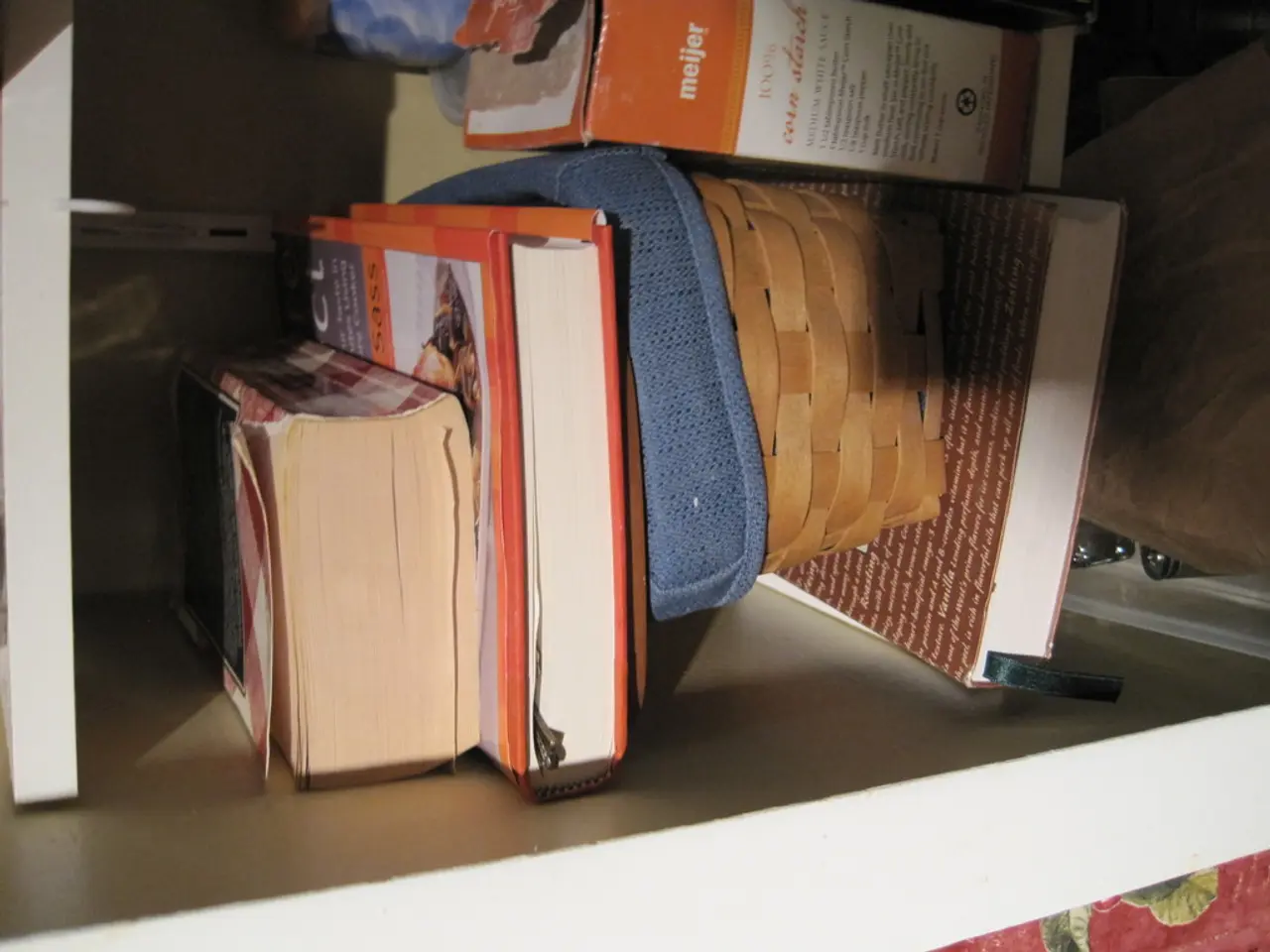"Homeschool Essentials: 7 Resourceful Ways to Arrange Your Supplies for a Harmonious Blend of Creativity and Nature-Inspired Education"
Creating an Efficient Homeschool Organization System
Transform your home into a functional learning environment with this easy-to-follow guide on organizing homeschool supplies using rolling carts, mason jars, pegboard systems, and repurposed furniture.
1. Designate Zones for Different Activities and Materials
Repurpose existing furniture such as dressers, shelves, or tables to serve as foundational storage units for books, binders, and larger supplies. Get creative with your space and tailor the design to your homeschool needs.
2. Incorporate Rolling Carts for Mobility and Flexibility
Rolling carts with multiple tiers can hold frequently used supplies like pencils, markers, glue, scissors, and paper. Because they are mobile, you can move the cart between learning areas or store it away when not in use, helping keep your space clutter-free.
3. Use Mason Jars for Small Supplies and Sorting
Mason jars are ideal for organizing small items such as pens, crayons, paintbrushes, flashcards, or counters. Label each jar clearly to make it easy for kids to find and put away supplies independently.
4. Set Up Pegboard Systems for Vertical Storage
Install a pegboard on a wall or the side of a shelving unit to hang tools, scissors, rulers, clipboards, or even small baskets with additional supplies. Pegboards maximize vertical space, keeping your most-used items visible and within reach.
5. Label Everything Clearly
Whether on mason jars, rolling cart drawers, or shelves on repurposed furniture, clear labeling promotes independence and quick clean-up.
6. Create Defined Learning Stations
Using your furniture and storage system, create dedicated learning spaces such as a reading nook with bookshelves, a crafting station with rolling carts and jars, and a study area with pegboard tools and planners.
7. Incorporate Planners and Calendars for Scheduling
Use printable homeschool planners or binders (which can be stored in the system) to keep track of lessons, attendance, and projects. Flexible scheduling resources help adapt the homeschooling day to your family’s rhythm.
8. Utilize Mason Jars for Wall-Mounted Storage Displays
Mount mason jars on walls for wall-mounted storage displays, perfect for subject-specific storage of homeschool supplies.
9. Limit Each Caddy's Weight to Prevent Spills
Ensure kids can transport supplies between floors safely by limiting each caddy's weight.
10. Add Wheels to Larger Caddies for Easy Movement
Add wheels to larger caddies for effortless movement across different flooring surfaces.
11. Assign Colors to Each Academic Subject or Individual Child
For a visual color-coding system, assign colors to each academic subject or individual child. Update seasonal materials using the same color principles.
12. Designate Separate Containers for Math, Science, and Language Arts
Designate separate containers for math, science, and language arts using clear plastic bins with secure lids. Pack math caddies with calculators, rulers, manipulatives, and scratch paper. Keep a rolling cart stocked with safety equipment and cleaning supplies for science areas.
13. Use Fabric Bins with Reinforced Bottoms for Durability
Choose containers with comfortable handles that children can carry without strain or assistance. Fabric bins with reinforced bottoms offer durability without excessive weight.
14. Mount a Spice Rack on the Wall for Art Supplies
Mount a spice rack on the wall to hold paint tubes and markers for art stations.
15. Create Dedicated Cabinetry for Science Experiments
Fill science containers with magnifying glasses, measuring tools, small notebooks, and collection bags.
16. Include Pencil Sharpeners and Erasers in Every Caddy
Don't forget essentials like pencil sharpeners and erasers in every caddy.
17. Apply the Color System to Every Storage Location
Apply the color system to every storage location throughout the home for a consistent organizational approach.
18. Use a Lazy Susan on the Table Surface for Shared Supplies
Store shared supplies like glue sticks and scissors in a lazy Susan on the table surface in art stations.
19. Storage Ottomans Can Serve Double Duty as Seating and Hidden Storage
Storage ottomans can serve double duty as seating and hidden storage for bulky seasonal supplies.
20. Create Reading Corners with Floating Shelves, Fabric Bins, Floor Cushions, and Reading Lamps
Create reading corners with floating shelves, fabric bins, floor cushions, and reading lamps to encourage a cozy, inviting atmosphere for reading.
With these steps, you can create an effective homeschool organization system that maximizes space, promotes ease of access, and enhances the learning environment for you and your children. For more inspiration on furniture styles suitable for homeschooling storage, consider wide bookcases with drawers for combined display and concealed storage, or tubs or stations within the organized system dedicated to age-appropriate activities, limiting certain supplies to homeschool hours.
[1] Flexible Homeschool Scheduling [2] Repurposing Furniture for Homeschooling [3] Creating Homeschool Learning Stations [4] Bookcases for Homeschool Storage [5] Homeschool Planners and Calendars
1. Extend the Organization Ideas Beyond School Supplies Integrate fashion-and-beauty essentials, food-and-drink accessories, home-and-garden items, and even pet paraphernalia into the organized system for an all-encompassing home arrangement.
2. Explore Creative Storage Solutions for Lifestyle Essentials Use mason jars for small fashion accessories, traveling toiletries, or garden seeds, and pegboard systems for utensils in the kitchen, tools in the garage, or instruments in a music studio.
3. Organize Relationships and Pets in the Home Designate dedicated spaces for family photos, memory books, or pet necessities, such as food, toys, and grooming supplies.
4. Plan Local Travel and Car Adventures Allocate areas for guidebooks, maps, and travel gear to facilitate convenient, well-prepared excursions.
5. Dedicate a Shopping Area in the Home Implement a designated storage solution for reusable shopping bags, coupons, or receipts to streamline routine shopping trips.
By incorporating these additions into the homeschool organization system, you will cultivate a well-organized and efficient lifestyle that thrives in a functional and harmonious living environment. Make it a personal and family-friendly space that effectively serves all aspects of life, be it learning, relaxing, or adventuring together.




